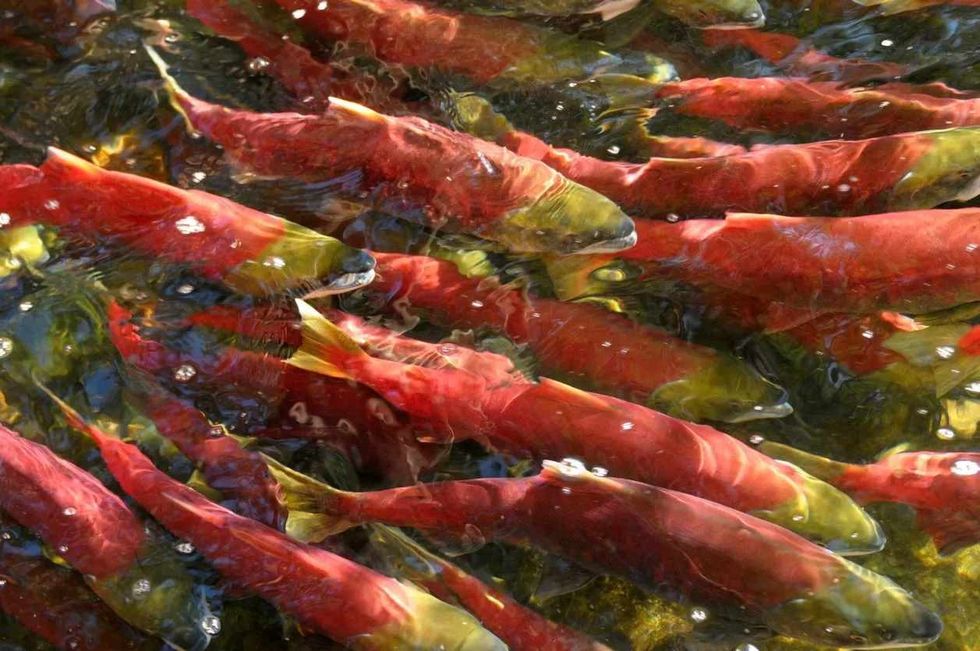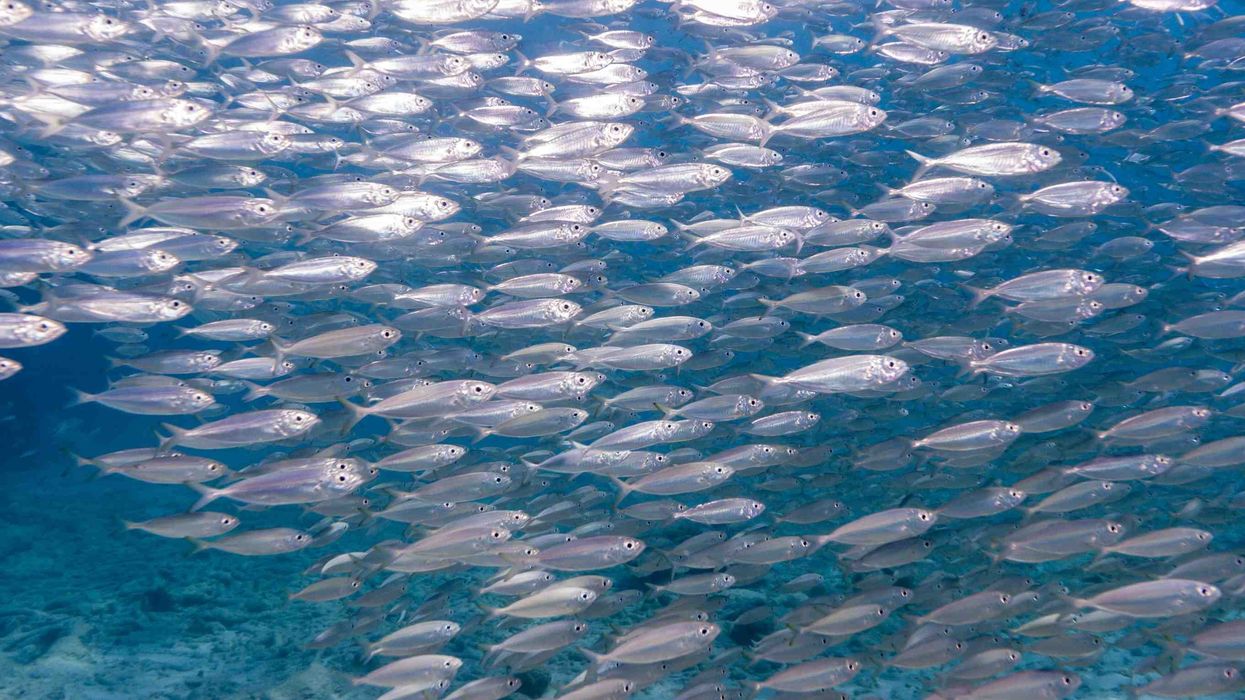Sockeye salmon is a species of pacific salmon belonging to the family Salmonidae. They are also known by their common name red salmon and blueback salmon.
Sockeye salmon are anadromous species which means they migrate from ocean to freshwater to spawn or breed. Although kokanee salmon, a type of landlocked salmon, do not migrate to the ocean and stay in the same freshwater lake throughout their life. They belong to the aquatic habitat consisting of rivers, lakes, and oceans.
Sockeye salmon return to freshwater streams during spawning. The females usually build nests called redds where they hatch around 45 - 200 eggs.
The sockeye has a bluish back with silver color on its body when living in the ocean and also on the migrating phase and hence the blueback name. They turn red and their heads become green in color to attract mates during breeding seasons.
According to the Internation Union for Conservation of Nature or IUCN Red List, sockeye salmon are listed as species of Least Concern.
Although habitat loss and climate change are some major threats faced by the sockeye salmon. To learn more fascinating facts about sockeye salmon, keep reading.
If you want to know about more interesting species, check out the pirahna and the walleye fish.
Sockeye Salmon Interesting Facts
What type of animal is a Sockeye salmon?
Sockeye salmon is a type of pacific salmon species which belongs to the family Salmonidae.
What class of animal does a Sockeye salmon belong to?
They are fishes belonging to the class Actinopterygii. The scientific name of sockeye salmon is Oncorhynchus nerka.
How many Sockeye salmon are there in the world?
There are around 65 million sockeye salmon fish present in the world.
Where does a Sockeye salmon live?
The migrating sockeye salmon species usually range from the Columbia River in the eastern Pacific to Hokkaido Island in the western Pacific.
They are also found eastward from Bathurst Inlet in the Canadian Arctic to the Anadyr River in Siberia to the west. The landlocked sockeye salmon populations commonly called kokanee salmon usually reside in British Columbia in Canada, in the states of Alaska, Wahington, Nevada, Idaho, Colorado, New York, Utah, Oregon, and more.
Among the lakes and rivers, they are mostly found in the Okanogan river, Baker river, Ozette Lake, Lake Pleasant, Lake Wenatchee, and Quinault Lake.
What is a Sockeye salmon's habitat?
Sockeye salmon fish is a species of pacific salmon that resides in the aquatic habitat constituting rivers, lakes, and oceans. Juvenile sockeye salmons migrate to the ocean in search of food present in abundance and hence they grow in size.
They are generally found 49.21 to 108.27 ft underwater. During spawning, they require clean freshwater lakes which are still and unsalted water bodies surrounded by land.
They are generally located in low-lying areas and are fed from rivers, streams, and runoffs from the adjacent areas. They also prefer cooler oceanic conditions.
Who do Sockeye salmons live with?
Sockeye salmon live in groups throughout its life and these groups are commonly known as schools.
How long does a Sockeye salmon live?
Sockeye salmon has a lifespan of four to five years in the wild.
How do they reproduce?
After growing in the ocean for three to five years, adult sockeye salmon return to freshwater to spawn. Sockeye salmons stop eating after returning to the breeding ground and conserve all their energy for reproduction.
During the process of reproduction or spawning, the largest male becomes more dominant over other smaller males and thus exhibits social hierarchy. The females are involved in building nests known as redds in the spawning grounds.
Fertilization is internal and eggs stay in the redds for some days. The female lays between 50 - 200 eggs in the redd.
Their body changes its color from the bluish back with silver sides to red and their heads become green to attract mates. The eggs take a span of six to nine weeks to hatch.
The females take part in the rearing process of the young sockeye known as fry. The fry is reared for one to three years.
They live in freshwater as juveniles and move to the ocean once they are able to survive and feed on their own. After spawning adult sockeye salmon usually die.
What is their conservation status?
According to the Internation Union for Conservation of Nature or IUCN Red List, sockeye salmons are listed as species of Least Concern. But some of the threats encountered by them include blocked access to the breeding ground, destruction of habitat due to mining and construction of the dams, overfishing, and change in climatic conditions.
The sockeye salmon populations in the United States are listed under the Endangered Species Act.
Sockeye Salmon Fun facts
What do Sockeye salmons look like?

Sockeye salmon (Oncorhynchus nerka) is one of the Pacific salmon species commonly known as blueback salmon, kokanee salmon, or red salmon. They usually have a blue-colored back with silver on their sides, hence the 'blueback' name.
They weigh around 2.2 - 8.8 lb (1 - 4 kg) and extend to 24.8 in (63 cm) in length. They exhibit this color combination during the juvenile phase and while migrating from the ocean in the adult phase.
They change their color to red with a green head during spawning to attract mates. Larger males with bigger snouts are preferred for reproductive success and males typically choose females with a red hue.
Their flesh becomes red in color because of the food they consume in the ocean which is high in carotenoids. During this time males develop a humped back and hooked jaws with tiny visible teeth.
They exhibit sexual dimorphism in their appearance. Males have a greater adipose fin length and hump height than females.
How scary are they?
The physical appearance of sockeye salmon makes them look quite scary.
How do they communicate?
The lateral lines present in them have an auditory function as they can detect vibrations. Their eyes are present on two opposite sides of the head thus creating a bigger range of vision.
They can see colors and ultraviolet rays through their eyes. They also have a great sense of smell which helps them to trace their way back to the home stream. This is what makes them special.
How big is a Sockeye salmon?
Sockeye salmon are usually 24.8 in (63 cm) in length. They are almost nine times the size of Fathead minnow (2.6 in - 2.8 in).
How fast can a Sockeye salmon swim?
Sockeye salmon can swim at a speed of 1.12 mph (1.8 kph) and cover long distances in the water.
How much does a Sockeye salmon weigh?
Sockeye salmon weighs approximately 2.2 - 8.8 lb (1 - 4 kg).
What are their male and female names of the species?
Scientists do not have a specific name for the male and female species of sockeye salmon. They are commonly referred to as male sockeye salmon and female sockeye salmon.
What would you call a baby Sockeye salmon?
Baby sockeye is usually called a fry.
Do humans eat them?
Humans do eat sockeye salmon. They are the best type of salmon to eat for they are rich in taste and filled with nutrients. However, they are more expensive than other Pacific salmon species because of their limited supply, higher demand, and better taste.
Are they dangerous?
There is no notable case of sockeye salmon attacking humans however, they engage in fights with each other. One female attacks the other due to limited space in the spawning grounds.
Would they make a good pet?
It is not recommended to keep the sockeye salmon fish as pets since they grow quite large in size. It might get unmanageable to keep such a large fish in confinement.
Did you know...
The word sockeye has been derived and anglicized from the word suk-kegh meaning redfish. It is a word from the Halkomelem language which is spoken by the native people living along the Fraser River in British Columbia.
What is the difference between sockeye salmon and salmon?
Sockeye salmon (Oncorhynchus nerka) can be differentiated from regular salmon on the basis of their color and other specific characteristics. Atlantic salmon have a pale orange color on their body while the sockeye salmon has a red hue.
They sometimes have black speckles which differentiate them from other species of Pacific salmon. Atlantic salmon and Chinook salmon are larger in size than sockeye salmon.
However, sockeye is larger than pink salmon. Sockeye salmon like other pacific salmon die after spawning but not all Atlantic salmon die after they spawn and complete some more reproductive cycles.
How to cook sockeye salmon?
Sockeye salmon are the best type of salmon to eat as they have a great taste and are rich in Omega 3. Sockeye can be cooked in a variety of ways with a concoction of ingredients.
Here are some legendary sockeye salmon recipes that are mouthwatering as well as easy. They can be served as grilled salmon topped with sauces. They can also be baked in foil or in the oven.
These fish can be served with pasta or rice that makes for an appetizing meal. Sockeye salmon can also be put in salads which will make it even healthier.
Here at Kidadl, we have carefully created lots of interesting family-friendly animal facts for everyone to discover! Learn more about some other fish including the wolffish and the brown trout.
You can even occupy yourself at home by drawing one of our Sockeye salmon coloring pages.










